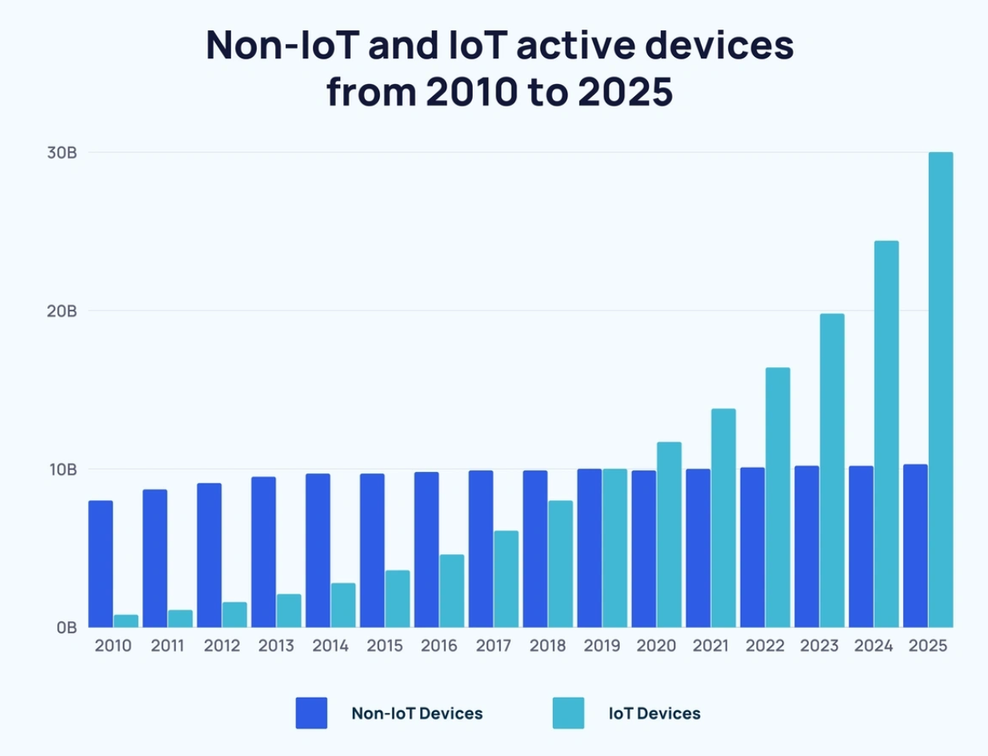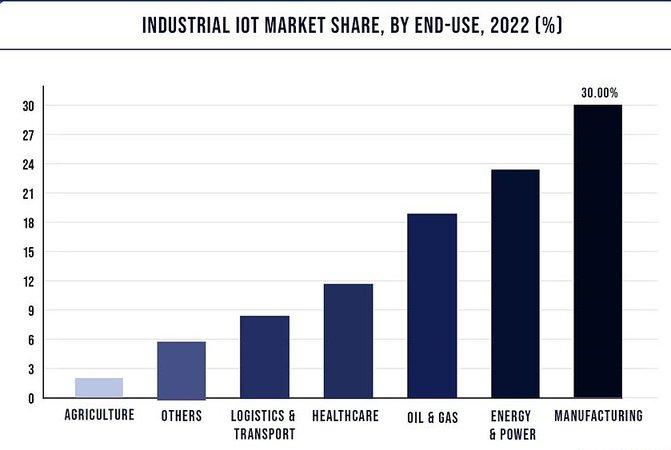Embracing the Future of Connectivity with Internet of Things (IoT)
Curious about how interconnected devices are reshaping our businesses? With a boost from technologies like 5G, data analytics, AI, and machine learning, IoT is transforming the way we live and work.

The IoT Revolution: Connecting Devices for a Smarter World
Let’s start from the beginning the term IoT was coined in 1999 by British technologist Kevin Ashton, the concept of the IoT envisioned a future where a vast network of interconnected objects would collect and analyze data, enabling them to perform tasks autonomously. While this idea once seemed like science fiction, today it is a rapidly unfolding reality. The number of IoT devices is said to double from 15.9 billion in 2023 to over 32.1 billion by 2030.
Imagine the possibilities when you leave behind manual tasks and not only automate them but also interconnect all the devices and systems in your business for real-time data collection and analysis. This digital transformation provides instant insights, enabling faster decision-making and enhancing responsiveness to market changes. With immediate access to up-to-date information, companies can optimize processes, reduce downtime, and improve customer experiences. This agility fosters a competitive edge, driving innovation and efficiency while reducing costs and mitigating risks.
What exactly is IoT?
IoT refers to a system of interconnected devices embedded with sensors and software that allow them to communicate and exchange data over a network without human intervention. With IoT, your office coffee machine will automatically order coffee beans when supplies run low and factory machines predict when they need maintenance. This seamless connectivity enhances productivity and efficiency.

Source: By 2030, 75% of all devices are predicted to be IoT.
Applications of IoT in Business
Manufacturing
Predictive Maintenance: Sensors monitor equipment health, predicting failures before they occur. For instance, a factory might use IoT sensors to detect vibrations or temperature changes in machinery, triggering alerts for preventive maintenance.
Process Optimization: Real-time data helps optimize production processes. For example, an assembly line can adjust speeds based on real-time data to maximize efficiency and reduce waste.
Supply Chain Management
Asset Tracking: IoT devices track goods in transit, providing real-time visibility. For example, logistics companies use GPS-enabled IoT devices to monitor the location and condition of shipments, reducing losses and improving delivery times.
Inventory Management: Automated systems monitor stock levels and trigger replenishment. Retailers can use IoT to track inventory levels in real-time, ensuring they always have the right amount of stock.

Trading and Service Industry
Enhanced Operations: Automatic Number Plate Recognition (ANPR) cameras can be used at car wash facilities to read and record the number of cars serviced. These interconnected cameras collect real-time data on vehicle visits, which can be analyzed to optimize staff scheduling, manage inventory, and provide personalized customer service.
Customer Service: Data can help in loyalty programs by tracking frequent customers and offering them special deals or discounts, improving customer satisfaction and retention.
Smart Cities
Traffic Management: IoT solutions optimize traffic flow. Cities use connected traffic signals and sensors to monitor and manage traffic, reducing congestion and improving safety.
Public Safety: Connected sensors and cameras enhance security. For example, IoT-enabled surveillance systems can detect unusual activity and alert authorities in real-time.
Dubai is using IoT technologies to make its city smarter as a part of its ‘Smart Dubai’ Initiative. In 2022 the IoT market in Dubai was around $ 1.6 Billion. With their IoT strategy, they aim to build the world’s most advanced IoT ecosystem.
| Running your business in Dubai? Smart cities require smart business practices. Let QCS help you with your digital transformation. Contact us now. |
Healthcare
Remote Patient Monitoring: Wearable devices collect health data and transmit it to healthcare providers. For instance, patients with chronic conditions can use IoT devices to monitor their vital signs at home, reducing the need for frequent hospital visits.
Asset Management: Hospitals use IoT to track medical equipment. This ensures that critical devices are always available and properly maintained.
The Future of IoT in Business
The integration of IoT with business applications is not just a trend but a transformative movement reshaping industries. As technology advances, IoT will continue to unlock new opportunities for innovation, efficiency, and growth. Businesses that leverage IoT effectively will gain a competitive edge, benefiting from enhanced operational capabilities, improved customer service and data-driven decision-making.
How QCS can help?
At Quark Cyber Systems (QCS), we specialize in Integrating IoT solutions with business processes to meet your business goals. Our expertise spans various industries, ensuring seamless integration and maximum benefits from IoT technology. From consultation to implementation and maintenance, we support you through every step of your IoT journey.
| Explore our innovative IoT solutions and discover how QCS can help your business thrive in the digital age. Know more |
Deepa Ramachandran
Juggling tech trends, art projects, and a love for storytelling—let’s explore it all together!

No comments yet. Login to start a new discussion Start a new discussion